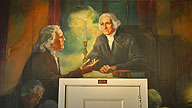The Stamford Historical Society Presents
Portrait of a Family: Stamford through the Legacy of the Davenports
John Davenport:
The American Career of an International Puritan
Lecture by
Francis J. Bremer, Ph.D.,
April 17, 2005
at the
Stamford Historical Society
[1]
print view
Who was John Davenport? First of all, he was an Englishman. Like the other founders of colonial America he was born in England – in his case the city of Coventry in the midlands – raised there, and there learned the ideas that would shape his entire career. And the world in which he was born was a world in which religion was central to all existence. His family worshipped in the Church of the Holy Trinity in Coventry. There, prior to the Reformation, parishioners entering the church had been confronted by the “Doom,” a graphic depiction of the Last Judgment such as found in many churches, designed to remind those who gathered for worship that their future included an eternity to be spent in heaven or in hell. During the lifetime of Davenport’s father the “Doom” was whitewashed over, because Protestants did not believe in iconographic decoration in their churches, but reformed ministers used the preached and written word to remind the Davenports and others of the same message.
When Davenport worshipped at Holy Trinity and studied at the town grammar school the outcome of the Reformation was still in doubt. The great reformers of the sixteenth century such as Luther and Calvin had challenged the teachings of the Catholic Church on the means to salvation, had rejected the authority of the pope, and over a period of time had developed new emphases in worship. Personal concerns had driven Henry VIII into the arms of the reformers, but from the break with Rome in the 1530s until 1597, when John Davenport was born, the character of England’s national church was contested, both between Protestants and Catholics and also between those who were content with the new reforms and those who felt further purification was necessary. No greater evidence could be found of the depth of religious convictions than the story of the martyrs of Queen Mary’s reign, whom the young John Davenport read about in John Foxe’s massive Acts and Monuments of the Christian Religion, popularly known as the Book of Martyrs. The stories and the woodcuts that illustrated them testified as perhaps nothing else can to the importance of religion in the lives of those who came to settle America – this was a world in which men and women would willingly die in the service of their God, and would also feel compelled to execute those who threatened to undermine a godly society.
Coventry was a center of religious reform and Davenport was raised in a godly household. From there he went to Oxford, where he matriculated at Merton College in 1613. After two years he transferred (migrated is the precise term) to Magdalen College, but he left the university before completing his degree. By this time he had experienced a spiritual rebirth, so that his intellectual consent to Calvinist doctrine was strengthened by the rapture of God’s caress. He left Oxford to accept a chaplaincy at Hilton Castle in county Durham where he honed his preaching skills. Like many young puritan preachers, he was perhaps something of a prig, indulging in moralistic criticism of his patron’s family. That might have had something to do with his brief stay there, though a more likely explanation was a call in 1619 to be curate of the parish of St Lawrence Jewry in London.
Continue reading [2] [3] [4]
© 2005, Francis J. Bremer
Portrait of a Family: Stamford through the Legacy of the Davenports


